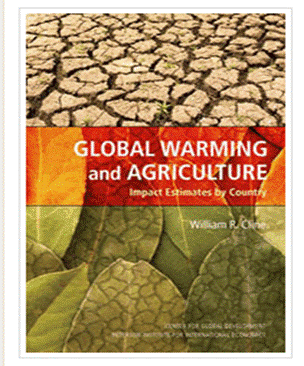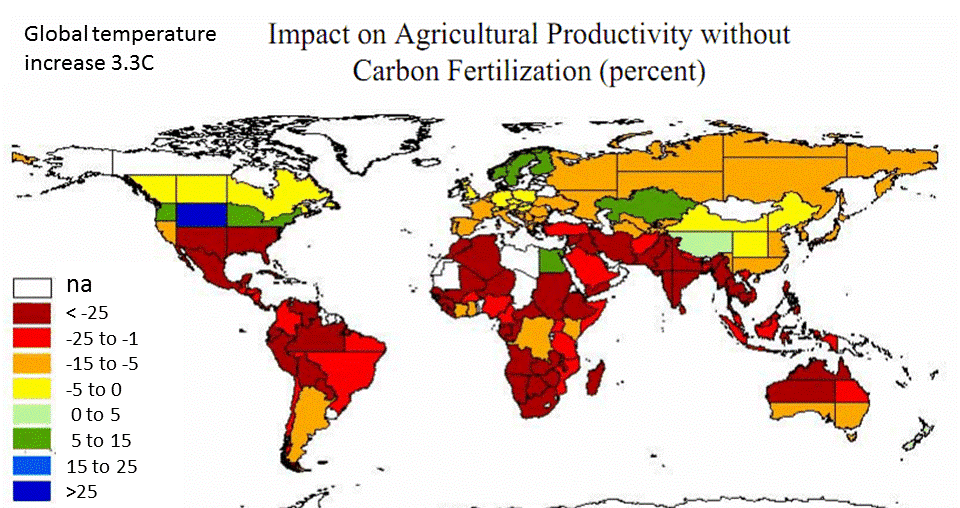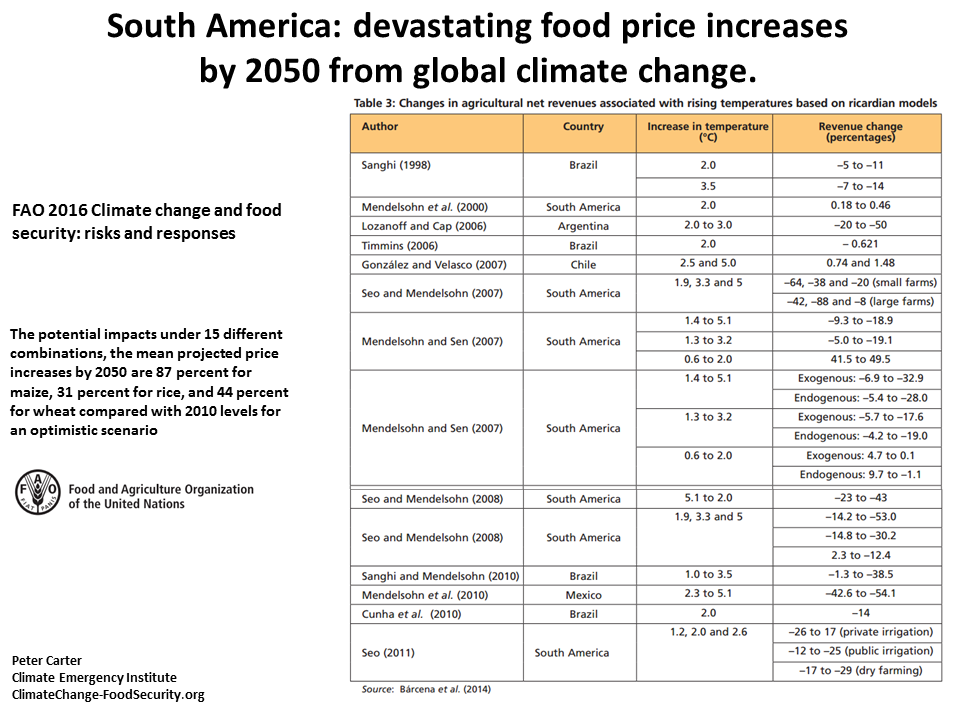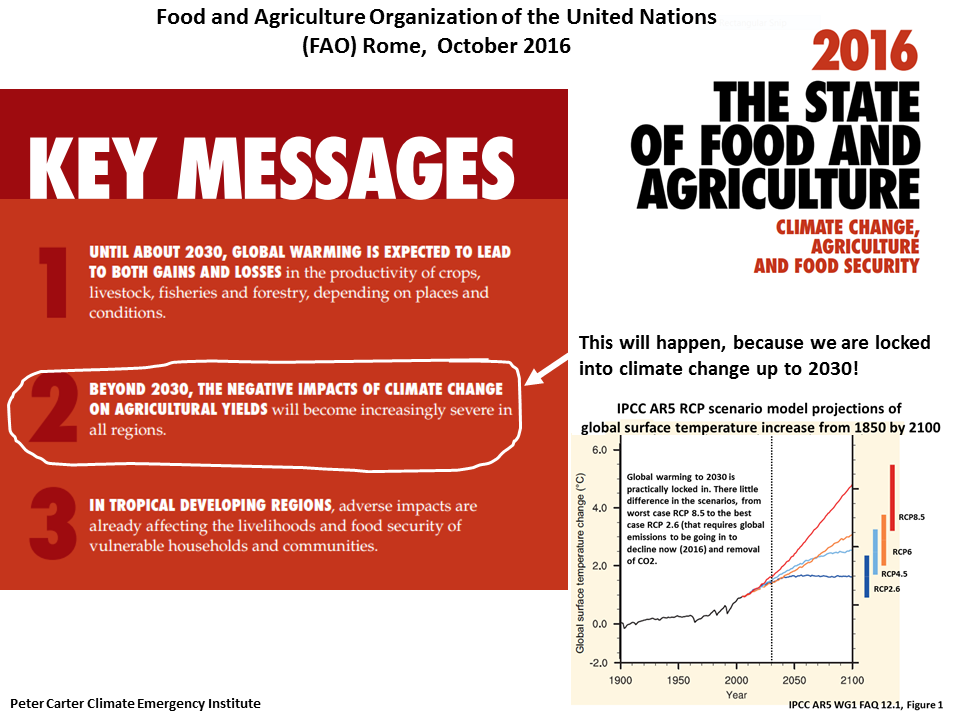
Global Warming and Agriculture: Impact Estimates by Country, W. Cline 2007
The 2007 Cline food security assessment was based on a global temperature increase of 3.3ºC. We are currently on track for a 3C rise by 2050. We are looking at the world that today's children will see.
The 2007 Cline food security assessment was based on a global temperature increase of 3.3ºC. We are currently on track for a 3C rise by 2050. We are looking at the world that today's children will see.
The climate models used in Cline's study predicted that under the IPCC's scenario A2 scenario (a high scenario as the world is on), that global mean temperature would rise by 3.3ºC, so these results are a for a global temperature of 3.3C. This is the increase that we are committed to by today's policy being the result if all national proposals were carried out (Climate Tracker).
Because of the uncertainty of the potential carbon fertilization benefits to some crops in some regions Cline gave results for crop yield changes with and without fertilization benefits.
Risk management demands that changes without fertilization would be the basis of food security security assessment, but instead the IPCC assesses based on the assumption of large CO2 fertilization benefits based on crop experiments of doubtful validity in the real world.

ClimateChange and FoodSecurity
Other reviews
Other reviews

Land areas would warm more than oceans, with the average surface temperature increasing by 5.0ºC weighting by land area and 4.4ºC weighting by farming area. By the 2080s, global agricultural productivity would decline by about 3% with carbon fertilization effect and by about 16% if the carbon fertilization effect did not materialize.
These losses would be disproportionately concentrated in developing countries, which would suffer losses of 9% with carbon fertilization effect and 21% without carbon fertilization effect, in contrast to an 8% gain (with carbon fertilization effect) and 6% loss (without carbon fertilization effect) in industrial countries. The detailed estimates by country and region reported in Table 2 indicate that South Asia and Africa would be the two regions most harmed by climate change. In Southeast Asia, the damages of climate change to agriculture would also be severe, ranking from 15.1% for Viet Nam to 26.2% for Thailand if carbon fertilization effect did not materialize..

Numerical table of results

Click for presentation


William
Cline is an agricultural economist. His report separates out the
potential CO2 fertilization effect.
However the report is on a global temperature increase of 3.3C and the IPCC says the CO2 fertilization effect no longer increases crop growth at 1.5-2.0C, therefore the Cline with CO2 fertilization does not apply.
However the report is on a global temperature increase of 3.3C and the IPCC says the CO2 fertilization effect no longer increases crop growth at 1.5-2.0C, therefore the Cline with CO2 fertilization does not apply.
Today global emissions are tracking this worst case IPCC scenario.
1. Climate Change & Agriculture US USDA 2013
2. Full Planet, Empty Plates: The New Geopolitics
ooof Food Scarcity Lester R. Brown 2012
3. William Cline 2007
4. Food & Forestry for a Warming Planet PNAS 2007
2. Full Planet, Empty Plates: The New Geopolitics
ooof Food Scarcity Lester R. Brown 2012
3. William Cline 2007
4. Food & Forestry for a Warming Planet PNAS 2007
March 2014 A Challinor Nature meta-analysisshows that crop yields will fall sooner than projected and decline sharply with temperature increase.
Report: Climate change could devastate agriculture - US February 5, 2013
A comprehensive USDA study concludes rising temperatures could cost farmers millions as they battle new pests, faster weed growth and get smaller yields as climate change continues.
• Climate change could cost farmers millions, study finds
• Warmer temperatures will make fighting pests, weeds more difficult
• Heat could make productivity of crops and livestock unpredictable (they will decline)
WASHINGTON — Climate change could have a drastic and harmful effect on U.S. agriculture, forcing farmers and ranchers to alter where they grow crops and costing them millions of dollars in additional costs to tackle weeds, pests and diseases that threaten their operations, a sweeping government report said Tuesday.
An analysis released by the Agriculture Department said that although U.S. crops and livestock have been able to adapt to changes in their surroundings for close to 150 years, the accelerating pace and intensity of global warming during the next few decades may soon be too much for the once-resilient sector to overcome.
"We're going to end up in a situation where we have a multitude of things happening that are going to negatively impact crop production," said Jerry Hatfield, a laboratory director and plant physiologist with USDA's Agricultural Research Service and lead author of the study. "In fact, we saw this in 2012 with the drought."
.A. Challinor Nature 2014 A meta-analysis of crop yield under climate change and adaptation . This meta-analysis found that Climate change will reduce crop yields sooner than thought. This was also the conclusion expert review in 2005 and the reasons are much the same.
J, Gornell 2010 Implications of climate change for agricultural productivity in the early twenty-first century (comprehensive)
Royal Society expert meeting 2005 Impact of climate change on crops worse than previously thought
Results were presented from a series of large-scale field experiments on crops such as maize, rice, soyabean and wheat, that show how increasing temperatures, drought and ground-level ozone concentrations (as predicted for the coming century#), will result in substantial reduction in crop yields, outweighing the beneficial fertilisation effects currently predicted from rising levels of atmospheric carbon dioxide. Growing crops much closer to real conditions has shown that increased levels of carbon dioxide in the atmosphere will have roughly half the beneficial effects that were previously hoped for in the event of climate change. In addition, ground-level ozone, which is also predicted to rise but has not been extensively studied before, has been shown to result in a loss of photosynthesis and 20% yield loss.: Both these results show that we need to seriously re-examine our predictions for future global food production as they are likely to be far lower than previously estimated.
Report: Climate change could devastate agriculture - US February 5, 2013
A comprehensive USDA study concludes rising temperatures could cost farmers millions as they battle new pests, faster weed growth and get smaller yields as climate change continues.
• Climate change could cost farmers millions, study finds
• Warmer temperatures will make fighting pests, weeds more difficult
• Heat could make productivity of crops and livestock unpredictable (they will decline)
WASHINGTON — Climate change could have a drastic and harmful effect on U.S. agriculture, forcing farmers and ranchers to alter where they grow crops and costing them millions of dollars in additional costs to tackle weeds, pests and diseases that threaten their operations, a sweeping government report said Tuesday.
An analysis released by the Agriculture Department said that although U.S. crops and livestock have been able to adapt to changes in their surroundings for close to 150 years, the accelerating pace and intensity of global warming during the next few decades may soon be too much for the once-resilient sector to overcome.
"We're going to end up in a situation where we have a multitude of things happening that are going to negatively impact crop production," said Jerry Hatfield, a laboratory director and plant physiologist with USDA's Agricultural Research Service and lead author of the study. "In fact, we saw this in 2012 with the drought."
.A. Challinor Nature 2014 A meta-analysis of crop yield under climate change and adaptation . This meta-analysis found that Climate change will reduce crop yields sooner than thought. This was also the conclusion expert review in 2005 and the reasons are much the same.
J, Gornell 2010 Implications of climate change for agricultural productivity in the early twenty-first century (comprehensive)
Royal Society expert meeting 2005 Impact of climate change on crops worse than previously thought
Results were presented from a series of large-scale field experiments on crops such as maize, rice, soyabean and wheat, that show how increasing temperatures, drought and ground-level ozone concentrations (as predicted for the coming century#), will result in substantial reduction in crop yields, outweighing the beneficial fertilisation effects currently predicted from rising levels of atmospheric carbon dioxide. Growing crops much closer to real conditions has shown that increased levels of carbon dioxide in the atmosphere will have roughly half the beneficial effects that were previously hoped for in the event of climate change. In addition, ground-level ozone, which is also predicted to rise but has not been extensively studied before, has been shown to result in a loss of photosynthesis and 20% yield loss.: Both these results show that we need to seriously re-examine our predictions for future global food production as they are likely to be far lower than previously estimated.
2015 USA Climate Change, Global Food Security, and the U.S. Food System.
Food security for the world will largely depend on the effects of global climate change on US agriculture. The USDA assessment shows that up to 2050 effects on the US food production will be mixed, with some large adverse impacts affecting some regions some times, but after 2050 yields will decrease generally.
Food security for the world will largely depend on the effects of global climate change on US agriculture. The USDA assessment shows that up to 2050 effects on the US food production will be mixed, with some large adverse impacts affecting some regions some times, but after 2050 yields will decrease generally.
2016 FAO Climate change and food security: risks and responses

Oct 2016 FAO The State of Food and Agriculture Climate change agriculture and food security
Excerpts
Beyond 2030, the negative impacts of climate change on the productivity
of crops, livestock, fisheries and forestry will become increasingly severe
in all regions.
Climate change to 2030 is practically locked in (see images).
'The impacts of climate change on agriculture and the implications for
food security are already alarming'
'The rapid change in the world’s climate is translating into more extreme
and frequent weather events, heat waves, droughts and
sea-level rise.'
'In many regions, agricultural production is already being adversely affected by rising temperatures,
increased temperature variability, changes in levels and frequency of precipitation, a greater frequency
of dry spells and droughts, the increasing intensity of extreme weather events, rising sea levels,
and the salinization of arable land and freshwater. As climate change impacts on agriculture intensify,
it will become increasingly difficult to grow crops, raise animals, manage forests and catch fish in
the same ways and in the same places as we have done in the past.'
The crops that we grow need specific conditions in order to thrive, including optimal temperature and sufficient
water. Up to a certain point, warmer temperatures may benefit the growth of certain crops in some parts of the world. However, if
temperatures exceed a crop’s optimal level, or if sufficient water and nutrients are not available, yields are likely to fall. An increased frequency of extreme events, especially floods and droughts, also harms crops and reduces yields. Dealing with drought could become a major challenge in areas where average temperatures are projected to increase and precipitation is projected to decrease. Many weeds, insect pests and diseases thrive under warmer temperatures, wetter climates and increased levels of atmospheric carbon dioxide (CO2). More extreme temperatures, combined with decreasing rainfall, can prevent crops from growing at all.'
'Heat waves, which are projected to become more common under climate change, directly threaten livestock. Over time, heat stress increases animals’ vulnerability to disease, thereby reducing fertility and meat and milk production. Climate change will also modify the prevalence of livestock parasites and diseases. In areas where rainfall increases, moisture-reliant pathogens are expected to thrive. Climate change also threatens the carrying capacity of grasslands and rangelands as well as feed production for non-grazing systems.'
'
'Fisheries and aquaculture – which provide at least 50 percent of animal protein to millions of people in low-income countries – are already under multiple stresses, including overfishing, habitat loss and water pollution (FAO, 2012). Climate change will exacerbate those stresses. Warmer water temperatures are likely to cause the extinction of some fish species, a shift in the habitat ranges of others, and increased risks of disease throughout the production chain.'
'A review of studies conducted for the Fifth Assessment Report of the Intergovernmental Panel on Climate Change (IPCC) suggests that while positive and negative projections of impacts on crop yields counterbalance each other at global level until about 2030, the balance after that becomes increasingly negative'.
'Beyond 2030, the negative impacts of climate change on the productivity of crops, livestock, fisheries and forestry will become increasingly severe in all regions. '
'The bulk of direct emissions of methane and nitrous oxide, two potent GHGs, are the result of enteric fermentation in livestock,
rice production in flooded fields, and the application of nitrogen fertilizer and manure, all of which can be reduced through the
implementation of better management practices.'
Excerpts
Beyond 2030, the negative impacts of climate change on the productivity
of crops, livestock, fisheries and forestry will become increasingly severe
in all regions.
Climate change to 2030 is practically locked in (see images).
'The impacts of climate change on agriculture and the implications for
food security are already alarming'
'The rapid change in the world’s climate is translating into more extreme
and frequent weather events, heat waves, droughts and
sea-level rise.'
'In many regions, agricultural production is already being adversely affected by rising temperatures,
increased temperature variability, changes in levels and frequency of precipitation, a greater frequency
of dry spells and droughts, the increasing intensity of extreme weather events, rising sea levels,
and the salinization of arable land and freshwater. As climate change impacts on agriculture intensify,
it will become increasingly difficult to grow crops, raise animals, manage forests and catch fish in
the same ways and in the same places as we have done in the past.'
The crops that we grow need specific conditions in order to thrive, including optimal temperature and sufficient
water. Up to a certain point, warmer temperatures may benefit the growth of certain crops in some parts of the world. However, if
temperatures exceed a crop’s optimal level, or if sufficient water and nutrients are not available, yields are likely to fall. An increased frequency of extreme events, especially floods and droughts, also harms crops and reduces yields. Dealing with drought could become a major challenge in areas where average temperatures are projected to increase and precipitation is projected to decrease. Many weeds, insect pests and diseases thrive under warmer temperatures, wetter climates and increased levels of atmospheric carbon dioxide (CO2). More extreme temperatures, combined with decreasing rainfall, can prevent crops from growing at all.'
'Heat waves, which are projected to become more common under climate change, directly threaten livestock. Over time, heat stress increases animals’ vulnerability to disease, thereby reducing fertility and meat and milk production. Climate change will also modify the prevalence of livestock parasites and diseases. In areas where rainfall increases, moisture-reliant pathogens are expected to thrive. Climate change also threatens the carrying capacity of grasslands and rangelands as well as feed production for non-grazing systems.'
'
'Fisheries and aquaculture – which provide at least 50 percent of animal protein to millions of people in low-income countries – are already under multiple stresses, including overfishing, habitat loss and water pollution (FAO, 2012). Climate change will exacerbate those stresses. Warmer water temperatures are likely to cause the extinction of some fish species, a shift in the habitat ranges of others, and increased risks of disease throughout the production chain.'
'A review of studies conducted for the Fifth Assessment Report of the Intergovernmental Panel on Climate Change (IPCC) suggests that while positive and negative projections of impacts on crop yields counterbalance each other at global level until about 2030, the balance after that becomes increasingly negative'.
'Beyond 2030, the negative impacts of climate change on the productivity of crops, livestock, fisheries and forestry will become increasingly severe in all regions. '
'The bulk of direct emissions of methane and nitrous oxide, two potent GHGs, are the result of enteric fermentation in livestock,
rice production in flooded fields, and the application of nitrogen fertilizer and manure, all of which can be reduced through the
implementation of better management practices.'

FAO-IPCC EXPERT MEETING ON CLIMATE CHANGE, LAND USE AND FOOD SECURITY, 23-25 January 2017
Climate change is expected to impact on crop production, livestock production, fisheries and aquaculture. There is robust evidence of negative impacts from heat and water stresses on crop yields
1.1 Projected productivity changes and extreme events
Climate change is expected to impact on crop production, livestock production, fisheries and aquaculture. There is robust evidence of negative impacts from heat and water stresses on crop yields
1.1 Projected productivity changes and extreme events
1.1.1 Crops
In terms of global temperature and the yield response curves for crops such as wheat and maize, the main change in
AR5 compared with the Fourth Assessment Report (AR4) is that a 1 or 2 ºC warming to increase yields in temperate
regions is no longer expected,